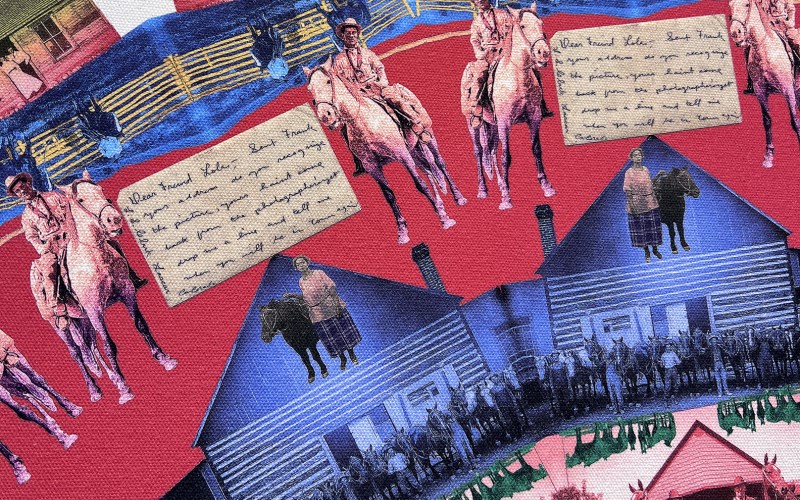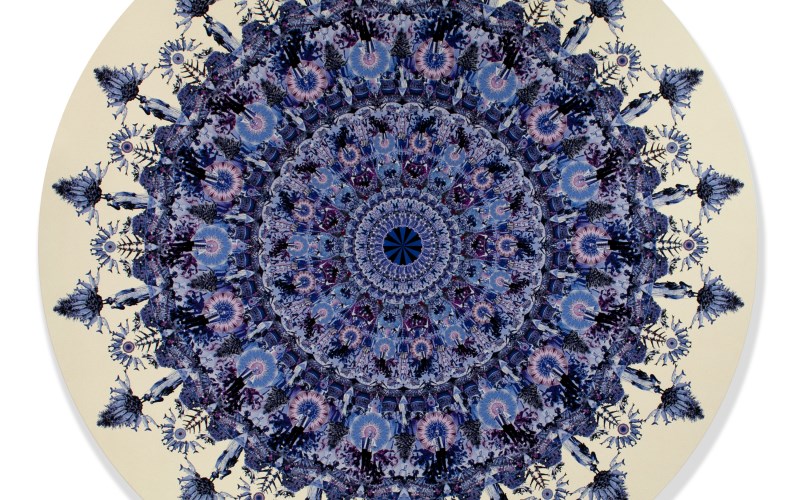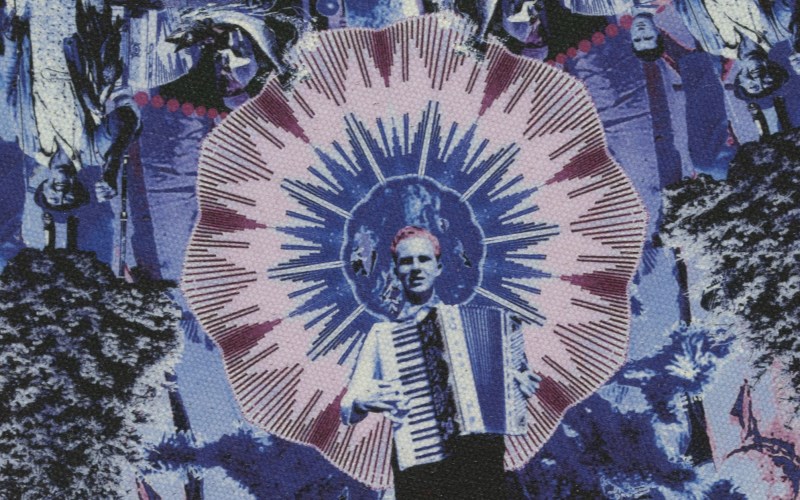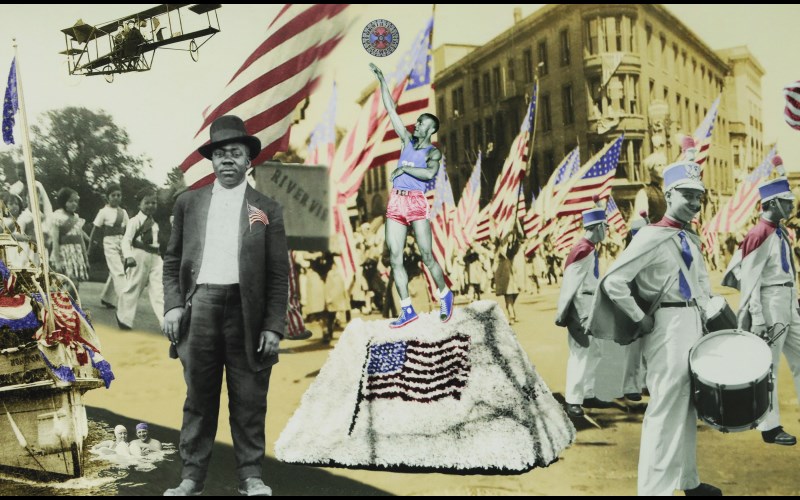|
BY KAREN BOSSICK Dana Hart-Stone mines estate sales and historical museums for snapshots. In his mind’s eye, they capture the everyday life of how America was built. He then manipulates these images into film-like strips and mesmerizing circular compositions, printing them on UV cured acrylic ink on canvas to showcase what otherwise might be a fading history. Some such as “Dear Friend Lola,” a 75-inch circular piece that pulsates as you view it, can be seen at Gilman Contemporary in Ketchum during Friday’s Gallery Walk from 5 to 7 p.m. on Feb. 14.
|
|

“Dear Friend Lola” was inspired by a short note a lonely cowboy wrote to his girl.
|
|
|
“I believe this is one of the aspects that makes his work so compelling—that from a distance, they read like textiles, but up close they reveal vignettes of history,” said Lauri Hoffman Bunting, of Gilman Contemporary. Growing up in the “very desolate, real tough country” of northeastern Montana, Hart-Stone spent his early years building things out of cardboard and mud while his brothers played with toy trucks. He was seven when his eyes were opened to the fading history around his hometown of Culbertson as he began walking out into the countryside where he found abandoned homesteads. “They were quite old, probably from the 1800s. And in them, I’d find broken pottery scattered around, leather boots, enamel pans, rusted barbed wire. Some of the homesteads had furniture in them and newspapers on the wall to keep out the 40-, 50-below weather,” he recounted. “The things I found absolutely fascinated me because I didn’t know the history of them. I didn’t know the people who had eked out a living where these homesteads--many of them, one-room buildings—were falling down. The fact that I didn’t know who these people were, what their story was, who wore the boots I found, who drank the coffee out of the broken pottery--it was a mystery to me and fascinated me no end.”
|
|

“Squeeze Box” is a mesmerizing 75-inch piece.
|
|
|
Forty years later, Hart-Stone acted on his fascination. He began collecting vintage, vernacular American photographs at estate sales, flea markets, antique shops and on eBay, trying to imagine as he looked at them who the people in the photographs were, where they lived, what they did and how they died. “I don’t use photographs by well-known photographers. I’m not interested in photographs that are beautifully composed. What I’m interested in is photographs that are snapshots of everyday life and most of them are from the West,” he said. Recently, Hart-Stone started downloading images from the Library of Congress, as he’s getting ready to do a big piece on former slaves. “The photographs you can get from the Library of Congress are amazing. Yale University also has huge collections. And you can find interesting photos—many from the 1890s, maybe earlier--at historical societies around the country. I found some beautiful pictures pre-1900 from Nebraska, some from the Scotts Bluff area of sod houses.”
|
|

“Squeeze Box” got its name from the accordion players within.
|
|
|
Hart-Stone scans the photos at a high resolution of 300 dpi and starts building his work on photoshop. He’s done film strips featuring sandy-yellow sepia-colored photographs. And, as a collector of American folk art, he’s woven strips together in photoshop to create the illusion of a woven textile. “I love patterns. When I moved to the Bay area a year ago, I had to pack 150 quilts. It fascinates me how women took parts of old fabrics and put them together to make extraordinary things.” At 69, Hart-Stone saw a lot of rickrack growing up, and he’s included that in some of his works. He’s created pieces spotlighting wheat, hay and alfalfa harvests and patriotic parades. And, when he noticed a lot of people photographed in plaid, he created “The Life and Times of Plaid,” which he realized later was an entry point into a piece about race, gender and socioeconomic positioning. He just finished a 75-inch circle featuring people standing on the tops of their horses.
|
|

Dana Hart-Stone has created a trilogy of pieces featuring patriotic parades and Statues of Liberty.
|
|
|
“Around the 19th and early 20th centuries, people were very interested in animal husbandry as they needed a good workhorse or team to bring food in to feed them through winter so they took great pride in their horses,” he said. “I’m trying to identify characters that show what it’s like to be an American in the West. This particular subject matter tells me Americans are pretty silly. I also have a photograph of six women who tied their hair to a clothesline, people wearing hats and costumes.” Hart-Stone loves to find photographs with writing on the back. That was the case with “Dear Friend Lola, which incorporates a vintage postcard photo of a cowboy who was lonely for his girlfriend and wrote a note starting “Dear Friend Lola.” “In the West, people were so lonely because they so isolated but they didn’t have a lot of room to write on the back of photographs,” he said. Given his background in painting ceramics, Hart-Stone prints his pieces on raw canvas with UV cured acrylic, using a UV light that dries and cures the ink instantly so the ink won’t fade like it might on regular inkjet printers. He stretches them and sprays them with a UV-protecting sealer.
Hart-Stone is currently working on pieces featuring wing walkers and Statues of Liberty that include a chocolate piece made in the shape of the Statue of Liberty, The pieces can be as big as 12-by-12-feet, taking him several months to build. He calls his circular pieces tondos or circle pieces. But the American University Museum dubbed them kaleidoscopes for their opening exhibition in January that drew the likes of Congressman Sen. Jamie Raskin. “From a distance, people see them as rich, interesting patterns,” said Hart-Stone. “When they get up close, they discover they’re all photographs—then they have a wonderful ‘aha!’ moment. After that, they start looking for photographs in the piece they can identify with.”
|